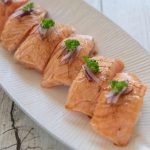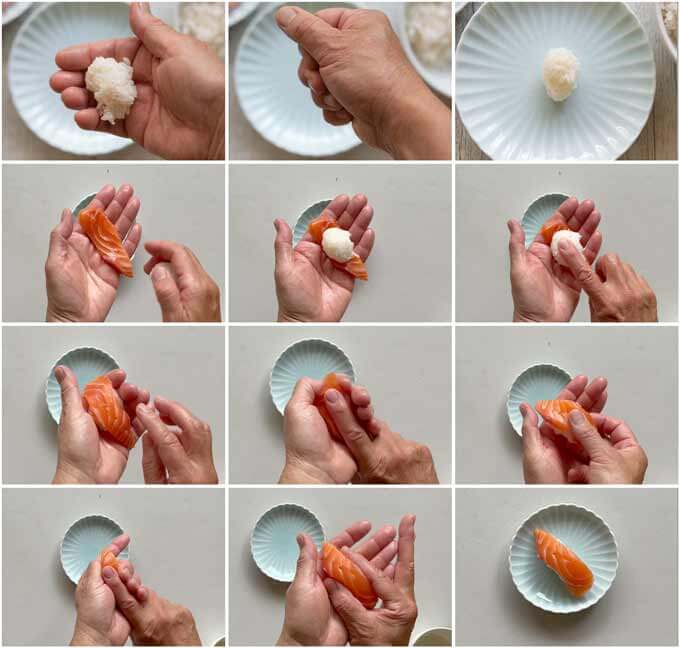
Seared Salmon Nigiri (Aburi Salmon) is very popular among Aussies, particularly with a sweet soy-based sauce brushed over the seared salmon. By searing it, the salmon becomes sweeter and more delicious. You will end up eating so many pieces without realising it.
Cook Time does not include the time to cook rice.
Don't forget to see the section 'MEAL IDEAS' below the recipe card! It gives you a list of dishes that I have already posted and this recipe that can make up a complete meal. I hope it is of help to you.
- 180-200g / 6.3-7.1oz salmon fillet , skinless (note 1)
- 180g / 6.3oz hot cooked rice (note 2)
- 2 tbsp rice wine vinegar
- 2 tbsp water
- 15ml / 0.5oz rice wine vinegar
- 1 tsp sugar
- ⅛ tsp salt
- 2 tbsp finely sliced red onion (about 3cm / 1¼" long)
- Sprigs of curly parsley
-
Put all the Tare ingredients in a small saucepan and bring it to a boil. Bring the heat down and simmer gently until the liquid reduces to about half of the original quantity.
-
Put the Sushi Rice Vinegar ingredients in a bowl and mix well until the sugar is dissolved.
-
Sprinkle the Sushi Rice Vinegar over the hot rice in a bowl and mix using a spatula. Move the spatula in a cutting motion so that you don’t break the rice grains. Cover the bowl with a wet kitchen towel/kitchen paper.
-
Slice the salmon fillets into 3-5mm / ⅛-3⁄16" thick pieces using the sogi-giri (slant cutting) method. Each slice should be about 3cm / 1¼" wide, 8cm / 3⅛" long (note 4).
-
Mix the Tezu ingredients in a small bowl.
-
Wet both palms with the tezu, massage hands ensuring that all fingers including between the fingers are wet (note 5). Then clap your hands once so that the excess liquid will be splashed and eliminated.
-
Take 1/12 of the rice (about 15g / 0.5oz) in your right hand and squeeze the rice gently to make a ball (about 3-3.5cm / 1¼-1⅜" in diameter).
-
Place a salmon piece across the proximal phalanx (base section of the fingers) of your left hand (for the right hander).
-
Place the rice ball on the centre of the salmon piece, then make a dent in the centre of the rice with your right index finger (to air the rice).
-
Turn the sushi over by rolling it towards the tips of your fingers and move it to where the salmon piece was placed initially.
-
Place your right index finger on the salmon, place the left thumb on the edge of the rice and squeeze the left hand gently while pressing the index finger slightly (to firm up the entire sushi piece).
-
Turn it around 180 degrees and do the same so that the shape of the sushi becomes a rounded rectangle.
-
With your right thumb and the index finger, hold the sides of the sushi including the edge of the salmon piece, and squeeze very gently (to shape and wrap the sushi with the salmon).
-
Repeat for the remaining salmon pieces.
-
Place the salmon nigiri pieces on a heat resistant plate or a tray. Using a blowtorch, sear the surface of the salmon until it begins to lightly char.
-
Brush the tare over the salmon a couple of times, then place a small amount of sliced red onion topped with a tiny sprig of parsley if using.
1. The mid-body portion of the fillet is easier to slice if you are not used to making sashimi slices out of it. The belly portion of the fillet is trickier to slice but it is richer in flavour.
2. For sushi, you need to use either short grain rice (standard Japanese rice) or the rice sold as 'sushi rice' as the grains stick together better.
3. Most sushi shops in Japan do not use tare on Aburi Salmon. They serve Aburi Salmon expecting the diners to dip it in soy sauce, just like other raw fish nigiri sushi.
But in Australia, it is common to get Aburi Salmon sushi with sweet soy-flavoured tare brushed on it.
If you want to serve salmon nigiri without tare, I'd suggest that you put a small amount of wasabi paste on the salmon piece before putting the rice on.
4. If your fillet is large, cut it in half so that the width of the fillet is close to or slightly shorter than 8cm / 3⅛". The white fat lines should be running perpendicular or diagonal to the width.
Sogi-giri allows you to slice a fillet into the required size and thickness more easily than the standard slicing method. Because of the way you place the blade at an angle, you can control the width, length, and the thickness of the slice better (see the step-by-step photo in the post).
5. This is to prevent the rice from sticking to your hands. Hands should be wet but not too wet. If excessively wet, brush your hands with a towel to remove excess liquid.
6.

7. Nutrition per piece.
serving: 38g calories: 64kcal fat: 2.1g (3%) saturated fat: 0.5g (2%) trans fat: 0.0g polyunsaturated fat: 0.6g monounsaturated fat: 0.6g cholesterol: 8.3mg (3%) sodium: 179mg (7%) potassium: 72mg (2%) carbohydrates: 6.9g (2%) dietary fibre: 0.1g (0%) sugar: 2.5g protein: 3.7g vitamin a: 1% vitamin c: 1% calcium: 0.3% iron: 1.5%